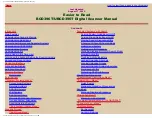
Easier to Read BCD396T/UBCD396T Digital Scanner Manual
channel controllers is assigned to be a master that all controllers report to. Each of these controllers sends out a data burst approximately every 10 seconds so that the
subscriber units know that the system is there. This data burst is not sent at the same time by all the channels, but happens randomly throughout all the system channels. If
you listen to the frequencies of an LTR system in manual mode (not trunking), on every channel in the system you will hear this data burst that will sound like a short blip of
static like someone keyed up and unkeyed a radio within about 500 msec. LTR systems are limited to 20 frequencies per system.
Trunkscanning
is basically scanning IDs that are programmed into ID locations (same concept as frequencies into channels.) You can then trunkscan just the
programmed IDs.
Trunktracking
is searching for
all
IDs in a system (same concept as searching for frequencies in a band.)
Radio Reference.com
has an excellent page explaining the various types of trunking systems in more detail
Understanding IDs
IDs
are what you see instead of frequencies when you monitor a trunking
system.
Motorola IDs
come in two formats: Type I and Type II. Each format displays and uses talk group IDs in slightly different ways.
Type I IDs
are in the format
FFF-SS
where
FFF
is the fleet and
SS
is the sub-fleet. Type I systems are usually organized with different IDs assigned to different
fleets. For example, a valid fleet/subfleet ID identifying all detectives within a police department might be 000-12, where 000 identifies all police IDs and 12
identifies the Detective division. To properly trunk a Type I system, you have to program the fleet map for the system.
Type II IDs
are identified by a 5-digit number.
Type I/II hybrid systems
use both fleet-subfleet and 5-digit formats for talk group IDs.
EDACS IDs
come in two formats:
AFS
and
Decimal
.
AFS IDs
are in the form
AA-FFS
where
AA
is the agency,
FF
is the fleet, and
S
is the sub-fleet. EDACS systems are organized with different IDs assigned to
different fleets and agencies. For example, a valid agency/fleet/subfleet ID identifying all detectives within a police department in an agency might be 06-101,
where 06 identifies the agency (Police), 10 identifies the Police division (East side), and 1 identifies the Detective division.
Decimal IDs
are shown as a decimal number from
0
to
2047
.
You can find a chart
showing Decimal and AFS IDs here:
I-Call IDS
(Motorola/EDACS only) are direct unit-to-unit transmissions that are not heard by other system users. I-call IDs are usually 6-digit IDs (ex: 700152).
LTR IDS
are in the format
A-HH-UUU
where
A
is the area code (0 or 1),
HH
is the home repeater (01-20), and
UUU
is the user ID (000-254).
Terms Used in this Document
Channel-
a programmed frequency
or
talk group ID location.
Searching-
the process of
searching
for
active frequencies
in quick search, service, custom search, Close Call search, auto search and store, or close call auto
store.
Scanning-
the process of
stepping
through
conventional channels
in groups, which are in programmed 'systems'.
Trunktracking (ID search mode)-
the process of
searching
for active
talk group IDs
in trunked systems.
http://marksscanners.com/396/396.shtml (7 of 51)8/17/2010 10:11:39 PM







































